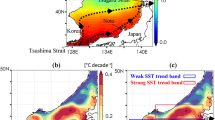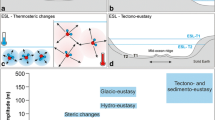Abstract
In this study, we used the National Centers for Environmental Prediction monthly sea surface temperature (SST) and surface air temperature (SAT) data during 1982–1994 and the National Center for Atmospheric Research surface wind stress curl data during 1982–1989 to investigate the Japan Sea SST temporal and spatial variabilities and their relations to atmospheric forcing. First, we found an asymmetry in the correlation coefficients between SST and wind stress curl, which implies that the SST variability at the scales of the order of one month is largely due to atmospheric forcing. Second, we performed three analyses on the data fields: annual mean, composite analysis to obtain the monthly anomaly relative to the annual mean, and empirical orthogonal function (EOF) analysis on the residue data relative to the summation of the annual mean and the monthly anomaly. The first EOF mode of SST accounts for 59.9% of the variance and represents the Subpolar Front. The temporal variation of the first EOF mode implies that the deep Japan Sea could be cooler in cold seasons (November–April) of 1984–1987. Third, we computed cross-correlation coefficients among various principal components and found that the atmospheric warming/cooling is the key factor causing intra-seasonal and interannual SST variabilities.
Similar content being viewed by others
References
Chu, P. C., H.-C. Tseng, C. P. Chang and J. M. Chen (1997a): South China Sea warm pool detected in spring from the Navy’s master oceanographic observational data set (MOODS).J. Geophys. Res. 102(C7), 15,761–15,771.
Chu, P. C., S. H. Lu and Y. C. Chen (1997b): Temporal and spatial variabilities of the South China Sea surface temperature anomaly.J. Geophys. Res. 102(C9), 20,937–20,955.
Gong, Y. (1968): On the seasonal variation of coastal surface water temperature.Bull. Fish. Res. Develop. Agency, No. 3, 57–79.
Hirai, M. (1994): Evaluation of the effects of winter cooling on sea surface temperature in the spring around Tsushima Current regions.Bull. Japan Sea Nat. Fish. Res. Ins., No. 44, 1–17.
Hong, C. H., K. D. Cho and S. K. Yang (1984): On the abnormal cooling phenomenon in the coastal areas of East Sea of Korea in summer 1981.J. Oceanol. Soc. Korea,19, 11–17.
Hotelling, H. (1993): Analysis of a complex of statistical variables into principal components.J. Edu. Psych.,24, 417–441, 498–520.
Isoda, Y. (1994): Interannual SST variations to the north and south of the Polar front in the Japan Sea.La Mar,32, 285–294.
Isoda, Y. and S. Saitoh (1993): The northward intruding eddy along the east coast of Korea.J. Oceanogr. 49, 443–458.
Isoda, Y., S. Saitoh and M. Mihara (1991): Sea surface temperature structure of the polar front in the Japan Sea. p. 103–112. InOceanography of Asian Marginal Seas, ed. by K. Takano, Elsevier New York.
Kano, Y. (1980): The annual variation of the temperature, salinity and oxygen contents in the Japan Sea.The Oceanogr: Mag.,31, 15–26.
Martin, S., E. Munoz and R. Drucker (1992): The effect of severe storms on the ice cover of the northern Tatarskiy Strait.J. Geophys. Res.,97(C11), 17,753–17,764.
Maizuru Mar. Observ. (1997): Climate Chart of the Japan Sea. Maizuru, Japan.
Moriyasu, S. (1972): The Tsushima current. p. 353–369. InKuroshio, Its Physical Aspects, ed. by H. Stommel and K. Yoshida, University of Tokyo Press, Tokyo.
Na, J.-Y., J.-W. Seo and S.-K. Han (1992): Monthly mean sea surface wind over the adjacent seas of the Korea Peninsula.J. Oceanol. Soc. Korea,27, 1–10.
Reynolds, R. W. (1988): A real-time global sea surface temperature analysis.J. Climate,1, 75–86.
Reynolds, R. W. and D. C. Marsico (1993): An improved real-time global sea surface temperature analysis.J. Climate,6, 114–119.
Reynolds, R. W. and T. M. Smith (1994): Improved global sea surface temperature analysis using optimum interpolation.J. Climate,7, 929–948.
Richman, M. B. (1986): Rotation of principal components.J. Climatology,6, 293–235.
Seung, Y.-H. and J.-H. Yoon (1995): Some features of winter convection in the Japan Sea.J. Oceanogr.,51, 61–73.
Trenberth, K. E., J. G. Olson and W. G. Large (1989): A global ocean wind stress climatology based on ECMWF analyses. NCAR Tech. Note, NCAR/TN-338+STR, 93 pp.
Weare, B. C., A. R. Navato and R. E. Newell (1976): Empirical orthogonal analysis of Pacific sea surface temperature.J. Phys. Oceanogr.,6, 671–678.
Author information
Authors and Affiliations
Rights and permissions
About this article
Cite this article
Chu, P.C., Chen, Y. & Lu, S. Temporal and spatial variabilities of Japan Sea surface temperature and atmospheric forcings. J Oceanogr 54, 273–284 (1998). https://doi.org/10.1007/BF02751702
Received:
Revised:
Accepted:
Issue Date:
DOI: https://doi.org/10.1007/BF02751702




